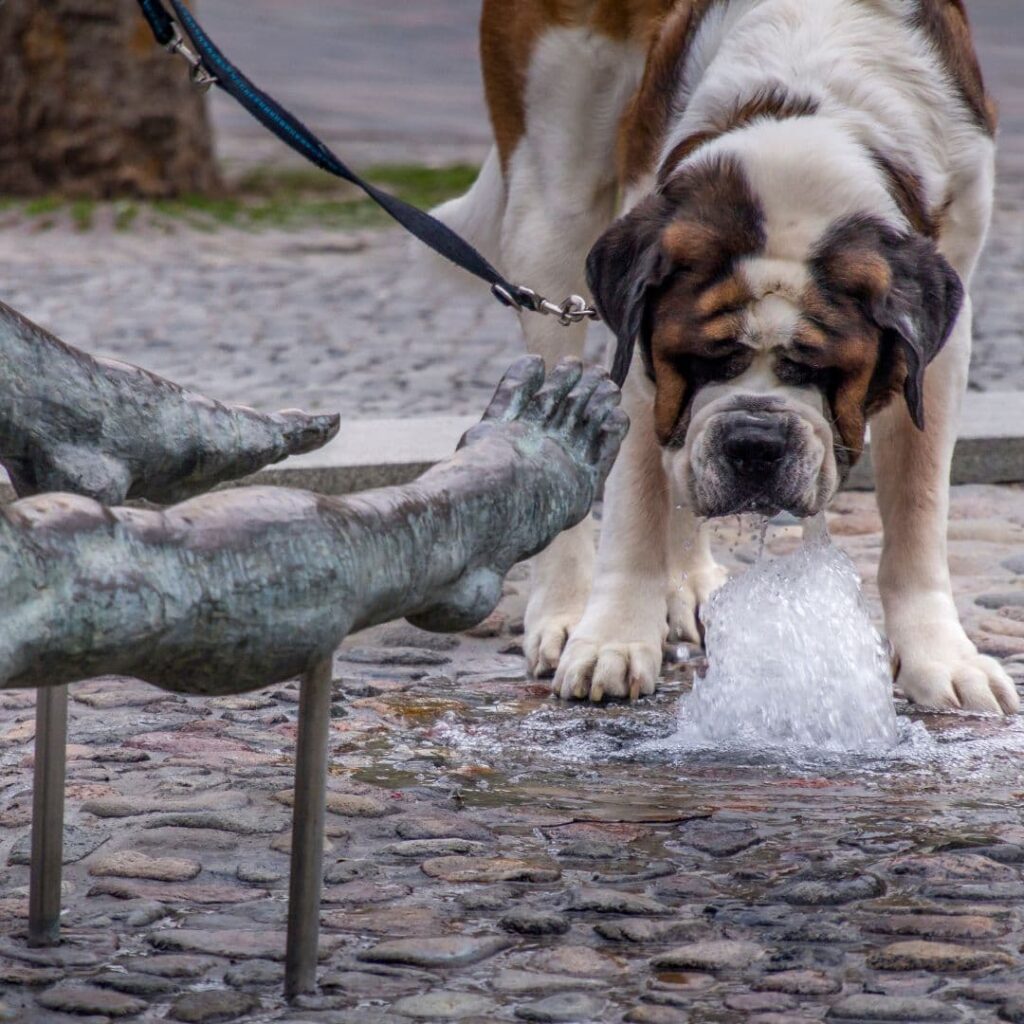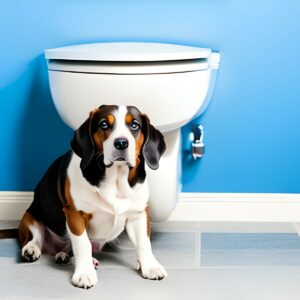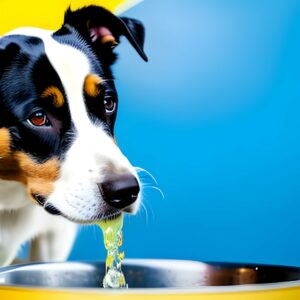If you’ve noticed that your old dog is drinking a lot of water, it could indicate a potential health issue that needs attention. While dogs typically drink about one cup of water per 10 pounds of body weight, excessive water intake in old dogs may be a sign of underlying conditions such as kidney failure, diabetes mellitus, Cushing’s disease, dehydration, etc.
We will explore together 11 reasons why an old dog is drinking a lot of water, how to recognize the symptoms, and what to do about it.
Old Dog Drinking A Lot of Water: Table of Contents
Normal vs. Increased Water Intake in Older Dogs
Normal water intake for dogs is approximately one ounce of water per pound of body weight per day.
For example, if your dog weighs 50 pounds, they should consume around 50 ounces of water each day. However, this can vary depending on your dog’s diet, activity level, and environment.
One of the best ways to monitor your dog’s water intake is to measure how much water they drink each day.
This can help you detect any significant changes in their drinking habits.
To measure your dog’s daily water intake, start by filling their water bowl to the same level each day. Keep track of how much water you add to the bowl and how much is left at the end of the day. Subtract the amount left from the amount you added to get your dog’s daily water intake.
Your dog’s water intake may vary depending on factors such as their size, activity level, and the weather. For example, on hot summer days, your dog may drink more water than usual to stay hydrated.
Observing Changes in Drinking Habits
In addition to measuring your dog’s daily water intake, it is also important to pay attention to how often they are drinking water throughout the day.
If you notice a significant increase in their drinking habits, it may be a sign of an underlying health issue. For example, if your dog is drinking more water than usual and also urinating more frequently, it could be a sign of diabetes or kidney disease.
On the other hand, if your dog is drinking less water than usual, it could be a sign of dehydration or pain.
Watching for Signs of Dehydration
Dehydration can be a serious problem for dogs, especially during hot weather or after exercise. Watch for signs of dehydration, including dry gums, lethargy, and loss of appetite.
If you suspect your dog may be dehydrated, seek veterinary care right away.
In addition to monitoring your dog’s water intake, you can also encourage them to drink more water by adding a splash of low-sodium chicken broth to their water bowl or offering them ice cubes on hot days. Remember, a well-hydrated dog is a happy and healthy dog!
Factors Contributing to Increased Thirst in Aging Dogs
- Decreased kidney function: their kidneys may not function as efficiently as they used to. This can lead to an increase in water intake as the body tries to flush out toxins and waste products.
- Infections and illnesses: can cause your dog to become dehydrated, which can lead to an increase in water intake. For example, if your dog has a urinary tract infection, they may drink more water to try to flush out the bacteria.
- Changes in metabolism: their metabolism may slow down, which can affect their fluid balance. This can lead to an increase in water intake as the body tries to maintain proper hydration levels.
- Certain medications and supplements: Some medications and supplements can cause your dog to become dehydrated or increase their thirst. For example, if your dog is taking a diuretic, they may drink more water to compensate for the increased urine output.
- Environmental factors: The environment can also play a role in your dog’s water intake. If your dog is spending more time outside in hot weather, they may drink more water to stay hydrated. Similarly, if your dog is spending more time inside in a dry environment, they may drink more water to compensate for the lack of humidity.
Common Health Issues Causing Excessive Thirst in Senior Dogs

Senior dogs are prone to several health issues that can cause excessive thirst:
- Kidney disease
- Diabetes
- Cushing’s Disease
- Liver Disease
- Urinary Tract Infections
Other Causes
6. Hot or Cold Weather
7. Changes in Diet
8. Medications and Supplements
9. Anxiety and Stress
10. Electrolyte imbalance
11. Dehydration
1. Kidney disease
Senior dogs’ kidneys may not function as well as they used to, leading to a condition called renal insufficiency.
This condition can cause symptoms:
- including increased thirst,
- frequent urination,
- weight loss,
- lethargy,
- poor appetite,
- vomiting,
- diarrhea,
- bad breath
The age of onset is often related to the size of the dog, and small dogs tend to show signs earlier than larger dogs.
There are several types of kidney issues that senior dogs can experience, including:
Acute kidney injury (AKI): This occurs when there is a sudden loss of kidney function. Common causes of AKI include dehydration, urinary tract obstruction, and infections.
Glomerulonephritis: This is an inflammation of the glomeruli, which are tiny blood vessels in the kidneys that filter waste from the blood.
Pyelonephritis: This is an infection of the kidneys and is more common in female dogs.
Renal dysplasia: This is a congenital condition in which the kidneys do not develop normally and can lead to kidney failure.
Renal amyloidosis: This is a condition in which amyloid proteins are deposited in the kidneys, causing them to malfunction.
Chronic kidney disease (CKD): This is the most common kidney disease in senior dogs and occurs when the kidneys gradually lose function over time.
Treatment for kidney disease in senior dogs depends on the severity and underlying cause of the disease.
Treatment options may include dietary changes, fluid therapy, medication, and in severe cases, dialysis or kidney transplantation.
It’s essential to diagnose and treat kidney disease early to manage the symptoms and improve the dog’s quality of life. If you notice any symptoms of kidney disease in your senior dog, I would recommend scheduling an appointment with your veterinarian for an examination and diagnosis because diagnosing and treating kidney disease early can help manage the symptoms and improve the dog’s quality of life.
2. Diabetes
This condition occurs when the body cannot produce enough insulin or use it effectively.
Common signs of diabetes in dogs:
- Increased thirst
- frequent urination
- weight loss,
- lethargy,
- poor coat condition
If left untreated, diabetes can lead to several complications, including:
- blindness,
- nerve damage,
- kidney failure,
- diabetic ketoacidosis
Diagnosis involves blood and urine tests to measure glucose levels and rule out other possible causes of symptoms.
Once diagnosed, treatment usually involves insulin injections, a tailored diet plan, and frequent monitoring of blood glucose levels.
3. Cushing’s Disease
Cushing’s Disease is a common condition in senior dogs that is also known as hyperadrenocorticism.
The condition is caused by a tumor in the pituitary gland, which leads to excessive production of the hormone cortisol. Cushing’s disease affects the adrenal glands and can cause excessive thirst in dogs.
Symptoms of Cushing’s disease include:
- weight gain,
- polydipsia (increased thirst),
- polyuria (increased urination),
- polyphagia (increased appetite),
- heat intolerance,
- lethargy,
- abdominal enlargement,
- panting,
- muscle weakness,
- recurrent urinary tract infections,
- alopecia (hair loss),
- thin, fragile skin,
- phlebectasias,
- comedones,
- bruising,
- cutaneous hyperpigmentation,
- calcinosis cutis,
- diabetes
Diagnosis of Cushing’s Disease in senior dogs is done by conducting blood tests to differentiate between disease caused by the pituitary or the adrenals.
An ultrasound may also be used to detect a tumor on an adrenal gland or pituitary gland.
There are different classifications of pituitary corticotroph adenomas that are responsible for Cushing’s disease in senior dogs, which are classified as functional ACTH-secreting PAs (ACTH-PAs).
Cushing’s Disease in senior dogs as it can lead to complications such as high blood pressure, kidney infections, bladder stones, chronic skin and urinary tract infections, changes in the liver, vacuolar hepatopathy, and an increased risk of clots.
Treatment options include medication, surgery, or radiation therapy, and your veterinarian will work with you to determine the best course of action for your senior dog’s health.
4. Liver Disease
Some common signs of liver disease in dogs include:
- vomiting,
- diarrhea,
- lethargy,
- loss of appetite,
- increased thirst,
- yellowing of the eyes or skin (jaundice)
There are several types of liver disease that can affect dogs, including:
Hepatitis: This is an inflammation of the liver, which can be caused by a variety of factors such as infection, toxins, or an autoimmune disease.
Cirrhosis: This is a progressive disease that causes scar tissue to form in the liver, leading to a loss of function over time. It can be caused by chronic hepatitis, chronic exposure to toxins, or chronic heart disease.
Cholangitis: This is an inflammation of the bile ducts, which can cause blockages and lead to liver damage. It is often caused by bacterial infections.
Neoplasia: This refers to the development of cancer in the liver, which can cause a range of symptoms such as weight loss, loss of appetite, and lethargy.
Your vet can perform blood work and other tests to diagnose the type and severity of liver disease and develop a treatment plan tailored to your dog’s specific needs. With proper management and care, many dogs with liver disease can live long, happy lives.
5. Urinary Tract Infections
This condition occurs when bacteria enter the urinary tract and cause an infection.
Urinary Tract Infections (UTI) symptoms:
- frequent urination,
- difficulty urinating,
- blood in the urine,
- licking the genital area excessively,
- foul-smelling urine
Here are some ways to diagnose and treat UTIs in senior dogs:
Urine sample analysis: A sterile urine sample can be obtained from the dog by cystocentesis and sent out for a culture and sensitivity test. The results can help determine the cause of the UTI and which antibiotics will be most effective.
Physical examination: A full physical exam should be performed by the vet, which includes checking the kidneys and bladder. The lower back area should be checked for sensitivity and any swelling of the limbs should be noted as possible signs of a urinary tract issue.
Treatment: Depending on the severity of the infection, the vet may prescribe antibiotics and pain medication. It’s important to complete the full course of antibiotics as prescribed to ensure the infection is fully treated. In more severe cases, hospitalization and intravenous fluids may be necessary.
If left untreated, urinary tract infections can lead to more severe health issues, including kidney damage and sepsis.
Other Causes of Old Dog Drinking A Lot of Water
In addition to health issues, several environmental and behavioral factors can cause increased thirst in dogs:
6. Hot or Cold Weather
If your dog is spending more time outdoors in hot weather, they may be drinking more water to stay hydrated.
Dogs regulate their body temperature through panting, which can cause them to lose fluids quickly. Consider adding ice cubes to their water bowl or investing in a doggy pool to help keep them cool.
Cold weather can worsen joint stiffness and pain in dogs with arthritis or joint issues. To support their achy body, dogs may become less active during the winter months, which can result in less water consumption.
However, when dogs do go outside in cold weather, they may start drinking more water to compensate for the loss of fluid through breathing and panting.
7. Changes in Diet
If you’ve recently changed your dog’s diet or are feeding them more salty or dry foods, they may be drinking more water to compensate for the change.
This is particularly true for dogs on a dry kibble diet, as they require more water to digest their food.
Consider switching to high-quality wet food to help prevent excessive thirst. Your veterinarian can recommend a diet that meets your dog’s specific nutritional needs.
Adding vegetables to your dog’s diet can help with hydration.
8. Medications and Supplements
Some medications and supplements can cause increased thirst in dogs. For example, diuretics, which are commonly used to treat heart failure and kidney disease, increase urine production and can lead to dehydration.
If your dog is taking any medications, talk to your veterinarian about the possible side effects and how to manage them. In some cases, adjusting the dosage or switching to a different medication may be necessary.
Supplements are a great addition to your senior dog’s diet, however, if not recommended by the vet, they to can cause increased thirst and counter-indications.
9. Anxiety and Stress
Dogs can experience anxiety and stress, which can lead to changes in behavior and increased thirst. For example, if your dog is anxious about being left alone, they may drink more water in anticipation of being without water for an extended period.
If you suspect your dog is suffering from stress or anxiety, speak to your veterinarian about possible treatment options. Behavioral modification techniques, such as desensitization and counterconditioning, can be effective in reducing anxiety and improving your dog’s overall well-being.
Anxiety beds are one of the options to help cope with stress.
10. Dehydration
Surprisingly dehydration can cause excessive water drinking in dogs especially if it’s followed by other symptoms such as diarrhea or vomiting.
Dehydration can lead to a loss of electrolytes such as sodium, chloride, and potassium, which have important functions in the body such as balancing pH and moving fluids.
Dehydration occurs when a dog isn’t drinking enough water to keep up with their body’s needs, or when drinking water doesn’t hydrate the body.
Symptoms of dehydration in senior dogs can include:
- sunken eyes,
- dry mouth,
- lethargy,
- loss of skin elasticity
If a senior dog is showing signs of dehydration, it’s important to take action immediately by offering small amounts of water or ice chips if the dog is vomiting, and calling a veterinarian for advice.
In some cases, the vet may need to provide intravenous fluids to restore the dog’s fluid balance. Preventing dehydration in senior dogs involves ensuring they have access to clean water and monitoring their water intake, especially during hot weather or after physical activity.
11. Electrolyte imbalance
Electrolyte imbalances in senior dogs can have serious consequences, affecting their muscle contraction, nerve conduction, and water balance.
Hyperphosphatemia, an excessive amount of phosphorous in the blood, can be a concern in senior dogs, and can be managed by measuring the dog’s phosphorus levels every 6-12 hours until the concentration of phosphorous remains stable within the normal range.
The veterinarian will try to identify the underlying cause of the imbalance by testing for other conditions like diabetes and high parathyroid hormone levels.
Sodium, chloride, and potassium are the most common electrolytes that require monitoring, as they play vital roles in regulating neurological, myocardial, muscular and cellular functions, and fluid and acid-base balance.
Recognizing and treating electrolyte derangements is an important role for veterinary nurses, especially in emergency and critical care patients.
Management of fluid and electrolyte disorders in critical patients is extremely important, as these secondary problems are often more complicated and more serious than the initiating disease process.
If you suspect your senior dog may have an electrolyte imbalance, it’s important to bring them to a veterinarian as soon as possible for proper diagnosis and treatment.
When Should You Be Concerned?

- If you notice that your senior dog is drinking more water than usual, it could be a sign of an underlying health issue.
- If your senior dog is urinating more often than usual, it could be a sign of kidney disease, diabetes, or Cushing’s syndrome.
- If your senior dog starts drinking water from unusual sources, such as the toilet, it could be a sign of an underlying health issue.
- If your senior dog is drinking more water but eating less, it could be a sign of a health issue.
- If your senior dog is lethargic, vomiting, or showing other signs of illness, it’s essential to consult with your veterinarian.
- If your dog is peeing blood.
Old Dog Drinking A Lot of Wate: takeaways
Senior dogs may drink more water than usual due to a variety of health issues, including kidney disease, diabetes, and Cushing’s syndrome.
Monitor your senior dog’s drinking habits and be aware of any changes that could indicate an underlying health issue. If you notice any concerning changes, consult with your veterinarian to address potential causes:
Kidney disease: One of the most common causes of increased water consumption in senior dogs is kidney disease, which can result in increased urination and thirst. This can be diagnosed through blood and urine tests and may require treatment such as medication or a special diet.
Diabetes: Diabetes mellitus can also cause increased thirst and urination in senior dogs, leading to increased water consumption. It is important to monitor blood sugar levels and provide proper treatment, such as insulin injections and a low-carbohydrate diet.
Liver disease: Liver disease can cause increased water consumption due to increased thirst and changes in metabolism. Treatment may include medication, special diets, and in severe cases, surgery.
Cushing’s syndrome: Cushing’s syndrome is a hormonal disorder that can cause increased thirst and urination in senior dogs. This can be diagnosed through blood and urine tests and may require medication or surgery.
Dehydration: Dehydration can cause a senior dog to drink more water. This can occur due to vomiting, diarrhea, or other illnesses that cause fluid loss. Treatment may involve fluid therapy to rehydrate the dog.
Electrolyte imbalance: An imbalance in electrolytes such as sodium and potassium can cause increased thirst and water consumption in senior dogs. Treatment may involve supplementation or dietary changes.
My Senior Paws is a participant in the Amazon Services LLC Associates Program, an affiliate advertising program designed to provide a means for sites to earn advertising fees by advertising and linking to Amazon.com. We also participate in other affiliate programs which compensate us for referring traffic.




